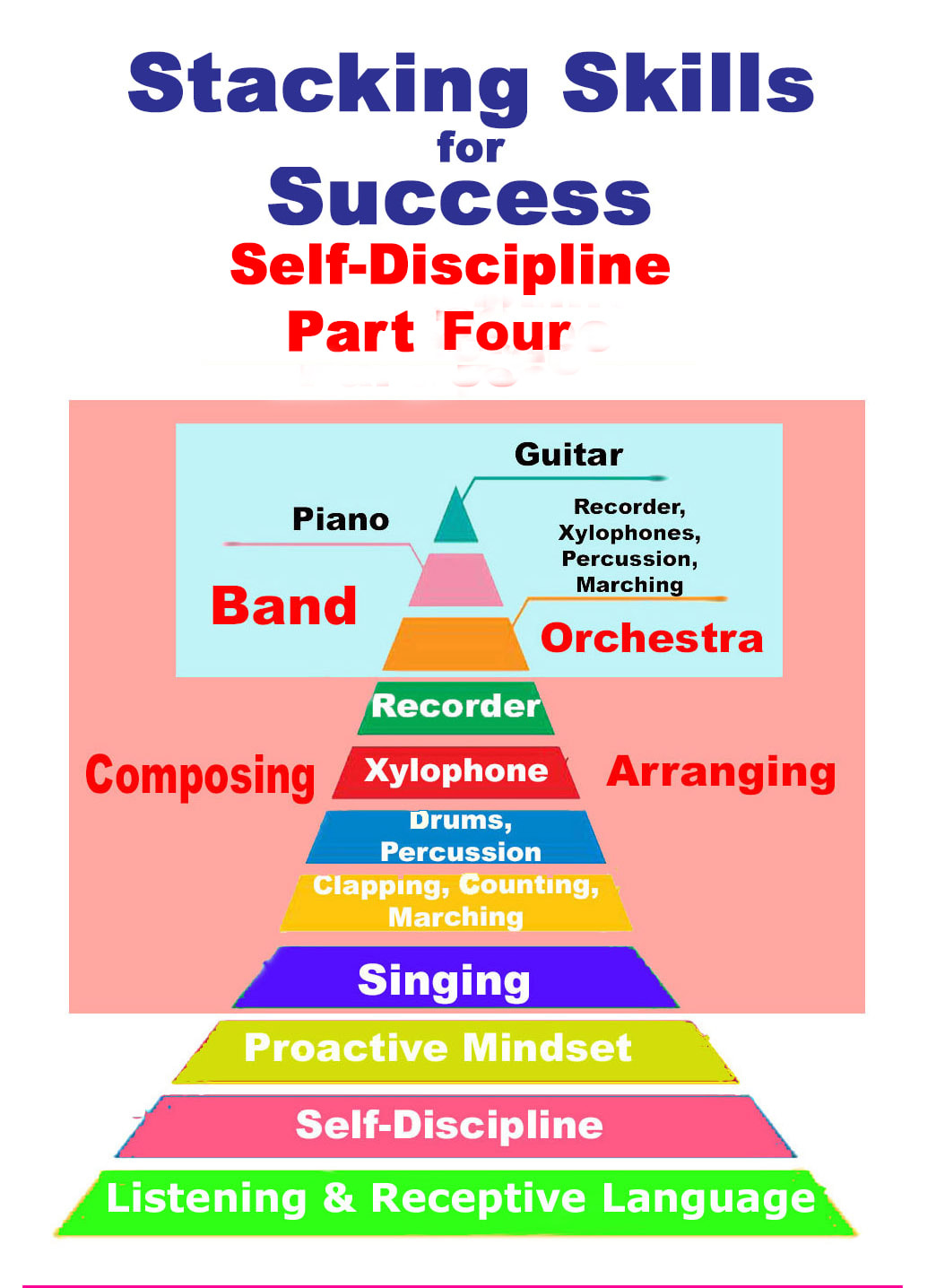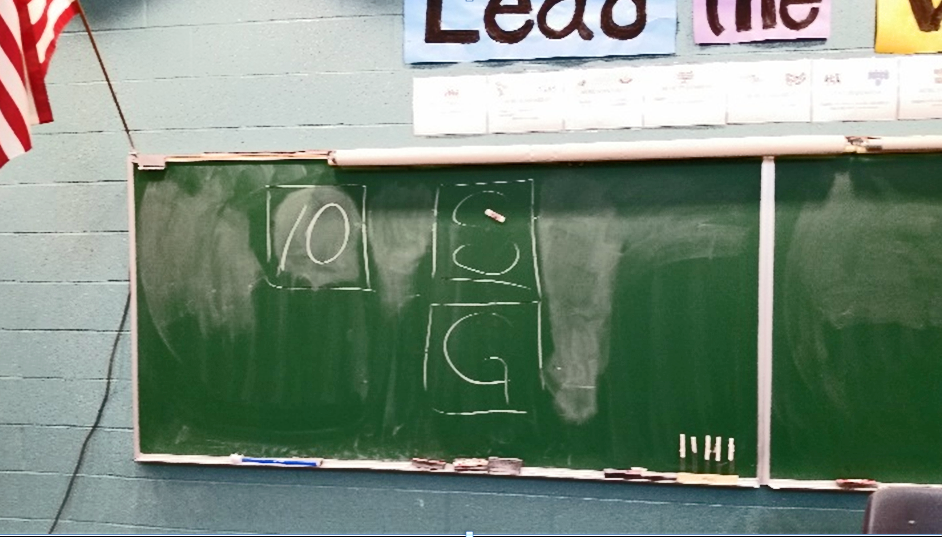Kids notice which teachers are self-disciplined. They will often ‘play’ undisciplined teachers because they know the reaction will usually be emotional and divert time from studies.
Screamers are not disciplined. Don't be a teacher who screams. Use visual imagery to convey your happiness, disappointment, or disapproval.
Enhanced self-discipline increases your own work output as well as your student’s productivity.
This is especially true with visually communicating to kids when or when not to talk.
Before any students ever walked into the music room, there were always two boxes drawn on the chalk board each about a foot wide.
One box had an “S” in it and one box had a “G”.
Stop and go.
Screamers are not disciplined. Don't be a teacher who screams. Use visual imagery to convey your happiness, disappointment, or disapproval.
Enhanced self-discipline increases your own work output as well as your student’s productivity.
This is especially true with visually communicating to kids when or when not to talk.
Before any students ever walked into the music room, there were always two boxes drawn on the chalk board each about a foot wide.
One box had an “S” in it and one box had a “G”.
Stop and go.
There was a magnet in the S as the kids entered the room.
For the rest of their educational life with me, I would never tell them to be quiet or stop talking.
The magnet and the pluses and minuses did that.
I did not say a word.
I saved hundred of hours by not saying "stop talking" that I was able to spend actually teaching,
My communication as far as my students' behavior was all delivered visually with only the most minimal aural input.
Actually, that's not accurate.
When I slammed that magnet on the S, it definitely got their attention from the get-go.
If I put the magnet on the S and they immediately got quiet, they got a a check under the plus column.
Let me be clear about how often I gave pluses and minuses at the beginning of the school year.
It was fast and furious at the beginning of the school year: at least plus/minus feedback every two to three minutes.
Whether it was a plus or a minus depended upon what they were doing in that exact moment.
The last week of school, I would often share a secret with my fifth grade class kid, the kids I had taught probably the most over the past few years.
“Do you know that some of you kids who I've taught for 5 years have never heard me say ‘stop talking’?
Not one time.
You've never had to hear me whine and complain like other teachers do about being quiet. The magnet always told you, not me.
And the “stop” and “go” were never really on the board - they were in your head – and will be there for the rest of your life to remind you when its time to work or to take a break.
There is a reason I never told you to be quiet.
Musicians never talk to other musicians that way.
And that's the way I've always wanted to talk to you, because I knew you were musicians just as I am a musician.
From the day I met you I knew you would be a musician and now, as we finish this last class, I know you will continue to be a musician for the rest of your life.”
At which point I'd act stuffy and professorial and say something like, “Now go forth, and make music!”
We would have a good laugh.
Self discipline with kids in the music room also hinges on how they see you, another visual component.
If you come in looking professional, you have greater chance of being treated like a professional.
If you come in dressed like its Casual Friday, don't be surprised if you get Casual Self-Discipline back from the kids.
I was known for wearing a black three-piece suit everyday. I had four of them.
The ties changed daily but the suit and vest remain the same.
A student once taught me a very crucial lesson.
A kid asked why did I always wore my tuxedo to school.
Now, of course it wasn't a tuxedo, it was just a three-piece suit. But in his mind, he thought it was the most expensive suit in the world.
I used my typical teacher ninja move and turn the question back on the class.
“Why do you think I wear my best three-piece suit everyday to school?”
One of the kid’s hand shot up.
“That's easy - it's because you respect us and you want to show how much you respect us by wearing your most respectable clothes.”
I thought long and hard about that kids answer on the way home from work that day and I'm not ashamed to say I got, as Maynard G. Krebs would say, a little misty thinking about the way they perceived our world together.
The easiest way to encourage an air of self-discipline, is to actually look self-discipline.
Kids notice these things and they make an impression upon them.
I'd always chuckle when a kid came to school on Halloween dressed as Mr. Holmes in a suit, tie, and glasses.
Another thing that I learned was because kids are much closer to my shoes than they are to my face, my shoes got a lot more compliments.
“I really like your shoes Mister Holmes, they're so shiny!”
“Well, Becky, I, along with my Rockport dress blacks, would like to thank you for that compliment.”
A few final thoughts about discipline and self-discipline in “Stacking Skills for Successes: Self-Discipline - Part 5”
For the rest of their educational life with me, I would never tell them to be quiet or stop talking.
The magnet and the pluses and minuses did that.
I did not say a word.
I saved hundred of hours by not saying "stop talking" that I was able to spend actually teaching,
My communication as far as my students' behavior was all delivered visually with only the most minimal aural input.
Actually, that's not accurate.
When I slammed that magnet on the S, it definitely got their attention from the get-go.
If I put the magnet on the S and they immediately got quiet, they got a a check under the plus column.
Let me be clear about how often I gave pluses and minuses at the beginning of the school year.
It was fast and furious at the beginning of the school year: at least plus/minus feedback every two to three minutes.
Whether it was a plus or a minus depended upon what they were doing in that exact moment.
The last week of school, I would often share a secret with my fifth grade class kid, the kids I had taught probably the most over the past few years.
“Do you know that some of you kids who I've taught for 5 years have never heard me say ‘stop talking’?
Not one time.
You've never had to hear me whine and complain like other teachers do about being quiet. The magnet always told you, not me.
And the “stop” and “go” were never really on the board - they were in your head – and will be there for the rest of your life to remind you when its time to work or to take a break.
There is a reason I never told you to be quiet.
Musicians never talk to other musicians that way.
And that's the way I've always wanted to talk to you, because I knew you were musicians just as I am a musician.
From the day I met you I knew you would be a musician and now, as we finish this last class, I know you will continue to be a musician for the rest of your life.”
At which point I'd act stuffy and professorial and say something like, “Now go forth, and make music!”
We would have a good laugh.
Self discipline with kids in the music room also hinges on how they see you, another visual component.
If you come in looking professional, you have greater chance of being treated like a professional.
If you come in dressed like its Casual Friday, don't be surprised if you get Casual Self-Discipline back from the kids.
I was known for wearing a black three-piece suit everyday. I had four of them.
The ties changed daily but the suit and vest remain the same.
A student once taught me a very crucial lesson.
A kid asked why did I always wore my tuxedo to school.
Now, of course it wasn't a tuxedo, it was just a three-piece suit. But in his mind, he thought it was the most expensive suit in the world.
I used my typical teacher ninja move and turn the question back on the class.
“Why do you think I wear my best three-piece suit everyday to school?”
One of the kid’s hand shot up.
“That's easy - it's because you respect us and you want to show how much you respect us by wearing your most respectable clothes.”
I thought long and hard about that kids answer on the way home from work that day and I'm not ashamed to say I got, as Maynard G. Krebs would say, a little misty thinking about the way they perceived our world together.
The easiest way to encourage an air of self-discipline, is to actually look self-discipline.
Kids notice these things and they make an impression upon them.
I'd always chuckle when a kid came to school on Halloween dressed as Mr. Holmes in a suit, tie, and glasses.
Another thing that I learned was because kids are much closer to my shoes than they are to my face, my shoes got a lot more compliments.
“I really like your shoes Mister Holmes, they're so shiny!”
“Well, Becky, I, along with my Rockport dress blacks, would like to thank you for that compliment.”
A few final thoughts about discipline and self-discipline in “Stacking Skills for Successes: Self-Discipline - Part 5”


 RSS Feed
RSS Feed